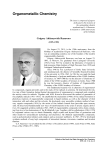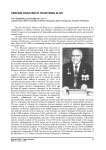Металлоорганическая химия. Рубрика в журнале - Вестник Южно-Уральского государственного университета. Серия: Химия
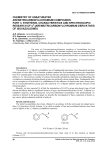
Статья научная
The series of η 6-(arene)tricarbonylchromium complexes of isoxazolidines has been obtained by 1,3-dipolar cycloaddition. The obtained compounds have been investigated by IR spectroscopy, 1H NMR spectroscopy and mass spectrometry. It has been shown that Cr(CO) 3 group significantly influences the structure and spectral characteristics of synthesized heterocycles.
Бесплатно
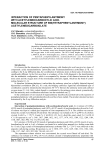
Статья научная
Bis(tetraphenylantimony) acetylenedicarboxilate (1) has been synthesized by the interaction of pentaphenylantimony with acetylenedicarboxylic acid (mole ratio 2:1 or 1:1) in toluene. In molecule 1 the acid anion has the bridging role and bonds Ph4Sb fragments. The antimony atoms have distorted trigonal bipyramidal coordination with the oxygen atom in the axial position. The Sb-O bond lengths are 2.287(4) and 2.389(4) Å, the Sb-C bond lengths are 2.110(7)-2.179(6) Å and 2.108(6)-2.165(6) Å.
Бесплатно
![Oxidation of tri( o-tolyl)antimony by tert-butyl hydroperoxide. Molecular structures of bis[µ 2-oxo-tri(o-tolyl)antimony] and µ 2-oxo- bis[( tert-butylperoxy)tri( o-tolyl)antimony] Oxidation of tri( o-tolyl)antimony by tert-butyl hydroperoxide. Molecular structures of bis[µ 2-oxo-tri(o-tolyl)antimony] and µ 2-oxo- bis[( tert-butylperoxy)tri( o-tolyl)antimony]](/file/thumb/147160326/oxidation-of-tri-o-tolyl-antimony-by-tert-butyl-hydroperoxide-molecular.png)
Статья научная
Tri( o-tolyl)antimony oxidation by equimolar amount of tert-butyl hydroperoxide in diethyl ether led to the formation of bis[µ 2-oxo-tri( o-tolyl)antimony] (1). At the molar ratio of reactants 1:2 or 1:4 µ 2-oxo- bis[( tert-butylperoxy)tri( o-tolyl)antimony] (2) has been formed. According to the X-ray analysis data, antimony atoms are in the trigonal bipyramidal coordination in molecules 1 and 2. The bond lengths Sb-O vary within the ranges 1.937(2)-2.078(2) Å (1) and 1.975(17)-2.216(15) Å (2).
Бесплатно
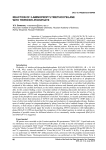
Reaction of 3-aminopropyltriethoxysilane with triphenylphosphate
Статья научная
Interaction of 3-aminopropyltriethoxysilane RNH 2 [R = (EtO) 3SiCH 2CH 2CH 2] with triphenylphosphate (PhO) 3P=O proceeds at temperature 180-200 °C and leads to formation of quaternary ammonium salt of phenylphosphoric acid [PhOP(O)O 2] 2-[PhH 2NR] 2+, which turns into liquid silicon-containing oligoamidophosphates RNH[P(O)(OPh)NR] nP(O)(OPh)NHR and phenol at high temperature. The latter transesterifies the original 3-aminopropyltriethoxysilane and the obtained products. With the use of high-temperature vacuum rectification liquid oligomers and the solid cross-linked polymer have been isolated. Heating of the solid polymer up to 1000 °C in inert atmosphere results in the amorphous phase, containing SiO 2 and NPO. The reactions of 3-aminopropyltriethoxysilane with triphenylphosphate and trimethylphosphate have been compared.
Бесплатно
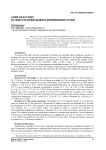
Some reactions of bis(cyclopentadienyl)diferrocenyltitan
Статья научная
Reaction of bis(cyclopentadienyl)diferrocenyltitanium Cp 2TiFc 2 (1) with iodine (toluene, 20 °C, 24 h) proceeds with formation of bis(cyclopentadienyl)titanium diiodide Cp 2TiI 2 (2) and diferrocenyl Fc-Fc (3); a byproduct of the reaction is the salt Fc-Fc-I 3 (4). Interaction of 1 with carbon monoxide (100 bar, benzene, 50 °C, 3 h) leads to the synthesis of diferrocenylketone (5) and bis(cyclopentadienyl) titanium dicarbonyl (6).
Бесплатно
![Synthesis and structure of bismuth complexes [p-Tol 4E] +3[Bi 3I 12] 3-•HOCH 2CH 2OC 2H 5 E=P, Sb Synthesis and structure of bismuth complexes [p-Tol 4E] +3[Bi 3I 12] 3-•HOCH 2CH 2OC 2H 5 E=P, Sb](/file/thumb/147160329/synthesis-and-structure-of-bismuth-complexes-p-tol-4e-3-bi-3i-12-3-hoch-2ch.png)
Synthesis and structure of bismuth complexes [p-Tol 4E] +3[Bi 3I 12] 3-•HOCH 2CH 2OC 2H 5 E=P, Sb
Статья научная
The interaction of equimolar amounts of tetra- p-tolylphosphonium and tetra- p-tolylstybonium iodides with bismuth triiodide in 2-ethoxyethanol leads to formation of the complexes [p-Tol 4E] +3[Bi 3I 12] 3-∙HOCH 2CH 2OC 2H 5 E=P (I), Sb (II). X-ray diffraction analysis of compounds (I) and (II) has shown that in the cations of complexes I and II the coordination of phosphorus and antimony atoms is tetrahedral (angles equal: CPC 107.3(3)°-113.4(4)° (I), CSbC 105.4(3)°-113.7(3)° (II); bond lengths for P-C and Sb-C are 1.761(9)-1.815(7) Å and 2.085(8)-2.099(8) Å, respectively). In trinuclear anions [Bi 3I 12] 3- the terminal fragments BiI 3 (Bi-Iterm 2.8714(5)-2.9181(5) Å (I), 2.8867(5)-2.9248(6) Å (II)) are bonded to the central bismuth atom through six μ2-bridging iodine atoms (Bi-Ibr 3.0454(6)-3.3891(6) Å (I), 3.0595(4)-3.3694(6) Å (II)).
Бесплатно
![Synthesis and structure of gold complexes [ p-Tol 4Sb][ p-TolAuCl 3] and [ p-Tol 4Sb][AuCl 4] Synthesis and structure of gold complexes [ p-Tol 4Sb][ p-TolAuCl 3] and [ p-Tol 4Sb][AuCl 4]](/file/thumb/147160338/synthesis-and-structure-of-gold-complexes-p-tol-4sb-p-tolaucl-3-and-p-tol-4sb.png)
Synthesis and structure of gold complexes [ p-Tol 4Sb][ p-TolAuCl 3] and [ p-Tol 4Sb][AuCl 4]
Статья научная
Gold complexes [ p-Tol 4Sb] +[ p-TolAuCl 3] - (1) and [ p-Tol 4Sb] +[AuCl 4] - (2) have been synthesized by interaction of tetra- para-tolylstibonium chloride and aurichlorohydric acid tetrahydrate in acetone. In 1 the tetra- para-tolylstibonium cations are tetrahedral (Sb-C 2.091(7)-2.097(6) Å, CSbC 106.1(3)°-112.7(3)°), the [p-TolAuCl3]- anions have square-planar structure (Au-Cl 2.286(2)-2.389(2) Å, Au-C 2.028(7) Å, ClAuCl 89.92(9)°, 92.42(9)°, 176.68(8)°, CAuCl 88.27(18)°, 89.57(18)°, 175.59(19)°). In crystal 2 the geometrical characteristics of cations (Sb-C 2.076(7)-2.097(9), CSbC 106.5(3)°-111.5(4)°) and [AuCl 4] - square-planar anions (Au-Cl 2.248(3)-2.278(3) Å, ClAuCl 89.17(9)°-90.74(13)°, 177.24(16)°, 177.61(13)°) are similar to those in 1.
Бесплатно
![Synthesis and structure of iridium complex [Ph 4Sb(DMSO)] +[IrCl 4(DMSO) 2] - Synthesis and structure of iridium complex [Ph 4Sb(DMSO)] +[IrCl 4(DMSO) 2] -](/file/thumb/147160334/synthesis-and-structure-of-iridium-complex-ph-4sb-dmso-ircl-4-dmso-2.png)
Synthesis and structure of iridium complex [Ph 4Sb(DMSO)] +[IrCl 4(DMSO) 2] -
Статья научная
Iridium complex [Ph 4Sb(DMSO)] +[IrCl 4(DMSO) 2] - (1) has been synthesized by interaction of tetraphenylstibonium chloride with sodium hexachloroiridate(III) in water. From X-ray diffraction analysis data, two types of crystallographically independent cations [Ph 4Sb(DMSO)] + and anions [IrCl 4(DMSO) 2] - exist in the crystal. The antimony atoms in cations have distorted trigonal-bipyramidal surroundings with O-dimethyl sulphoxide ligand in axial position (equatorial angles CSbC 113.6(2)°-121.2(2)°, axial angles CSbО 178.33(18)°, 176.47(18)°, bond lengths Sb-С eq 2.106(6)-2.119(6) Å, Sb-С ax 2.126(6), 2.130(6) Å, Sb-О 2.545(4), 2.465(4) Å). In mononuclear octahedral anions the equatorial positions are occupied by chlorine atoms (angles ClIrCl- trans 178.69(7)°-179.56(7)°, SIrS- trans 178.35(7)°, 175.88(7)°; dimethyl sulfoxide ligands are coordinated with iridium atoms through sulfur atoms (Ir-S 2.2958(16)-2.3148(17) Å), bond lengths Ir-Cl vary in the range 2.3407(19)-2.3681(17) Å. The structural organization in the crystal is determined by interionic hydrogen bonds (H∙∙∙Cl 2.80-2.94 Å and H∙∙∙O 2.56-2.71 Å).
Бесплатно
![Synthesis and structure of osmium complex [Ph 4P] 2[OsBr 6] Synthesis and structure of osmium complex [Ph 4P] 2[OsBr 6]](/file/thumb/147160324/synthesis-and-structure-of-osmium-complex-ph-4p-2-osbr-6.png)
Synthesis and structure of osmium complex [Ph 4P] 2[OsBr 6]
Статья научная
Tetraphenylphosphonium hexabromoosmate, [Ph 4P] 2[OsBr 6] (I), has been structurally characterized after synthesis by interaction of sodium hexabromoosmate with tetraphenylphosphonium bromide in dimethyl sulfoxide. The phosphorus atoms of [Ph 4P] + cations have distorted tetrahedral coordination geometry (СPС angles are 106.23(11)°-113.23(10)°), the P-С bond lengths are 1.791(2)-1.801(2) Å). In octahedral [OsBr 6] 2- anions the Os-Br bond lengths equal 2.4752(2)-2.5020(3) Å, trаns-BrOsBr angles are 180°.
Бесплатно
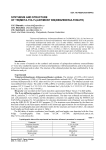
Synthesis and structure of tri(meta-tolyl)antimony bis(benzenesulfonate)
Статья научная
Tri( meta-tolyl)antimony bis(benzenesulfonate) m-Tol 3Sb(OSO 2C 6H 5) 2 (1) has been synthesized by interaction of tri( meta-tolyl)antimony with benzenesulfonic acid in the presence of tert-butyl hydroperoxide (mole ratio 1:2:1) in ether solution. Antimony atoms in 1 have trigonal-bipyramidal coordination with arenesulfonate substituents in axial positions (OSbO 171.05(11)°, CSbC 116.21(19)°, 117.38(18)°, 126.40(15)°). The Sb-C and Sb-O distances equal 2.091(4), 2.098(4), 2.115(4) and 2.105(2), 2.116(3) Å. Intermolecular contact (Sb•••O 3.421(3) Å) occurs between the central atom and the oxygen atom of sulfonate group.
Бесплатно
![Synthesis and structure of tri- and tetraphenylantimony aroxides: Ph 3Sb[OC 6H 3(Br 2-2,6)(Me-4)] 2 and Ph 4SbOC 6H 3Br 2-2,6, Me-4 Synthesis and structure of tri- and tetraphenylantimony aroxides: Ph 3Sb[OC 6H 3(Br 2-2,6)(Me-4)] 2 and Ph 4SbOC 6H 3Br 2-2,6, Me-4](/file/thumb/147160335/synthesis-and-structure-of-triand-tetraphenylantimony-aroxidesph-3sb-oc-6h-3.png)
Статья научная
Interaction of pentaphenylantimony with 2,6-dibromo,4-methylphenol or with bis(2,6-dibromo,4-methylphenoxy)triphenylantimony (1) leads to formation of 2,6-dibromo,4-methylphenoxytetraphenylantimony (2). In molecules of compounds 1 and 2 the antimony atoms have distorted trigonal-bipyramidal coordination with the oxygen atoms in axial positions (OSbO 179.20(15)° (1), OSbC 179.7(9)° (2)). The bond lengths Sb-C and Sb-O equal 2.090(5), 2.101(5), 2.110(5) and 2.088(4), 2.088(4) Å (1), 2.11(2), 2.11(2), 2.11(2), 2.17(3) and 2.234(18), 2.234(18) Å (2), respectively.
Бесплатно
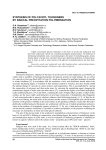
Synthesis of polyacryl thickeners by radical precipitation polymerization
Статья научная
Lightly cross-linked polymer thickeners on the basis of acrylic and methacrylic acid have been synthesized with the use of radical precipitation polymerization. The influence of introducing hydrophobic units, cross-linking degree, the nature of neutralizing agents, neutralization degree of acidic units, and other factors upon thickening properties of obtained polymers in water, as well as water mixtures with glycerol or propylene glycol, has been determined.
Бесплатно
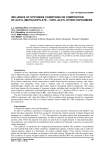
Влияние условий синтеза на состав сополимеров алкил(мет)акрилат-винилалкиловый эфир
Статья научная
Проведен синтез сополимеров метилметакрилата с винилбутиловым эфиром из мономерной смеси и компенсационным способом. Анализ их состава показал, что происходит образование, соответственно, неоднородного по конверсии сополимера с преимущественным содержанием звеньев метилметакрилата и сополимера близкого к эквимольному состава. На примере мономерной пары бутилакрилат-винилалкиловый эфир показано, что для получения композиционно однородного сополимера могут быть использованы как классические радикальные инициаторы, так и бинарные иницаторы боралкид-кислород.
Бесплатно

